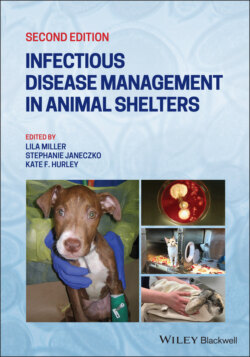Читать книгу Infectious Disease Management in Animal Shelters - Группа авторов - Страница 147
5.5.3 Respiratory Disease, General
ОглавлениеThe following collection would be a good starting point for sampling any respiratory disease of unknown origin in dogs or cats. While causes for respiratory distress can be remote from the respiratory system, most cases of infectious pneumonia or upper respiratory infections (URI) result from a direct attack on the respiratory tissues. Gross lesions of the lung are difficult to interpret. This is, in no small part, because there are often peri‐mortem lung changes, and such variability makes a baseline interpretation of “normal” very difficult. Histologic samples are of paramount importance when trying to discern factors contributing to lung disease. In cats, in particular, analyzing the upper respiratory tract as well as the lung is important; many common infections of the upper respiratory tract can contribute to fulminant respiratory disease, and severe URI is often interpreted as pneumonia (infection of the lower respiratory system).
1 Microbiology:In respiratory disease, depending on the lesions and clinical course, bacterial cultures can be taken from the nasal cavity, frontal sinus (swab immediately after opening) and/or lung. In general, because URI is so common in kittens and cats in a shelter, cultures should be taken from both the nasal cavity/sinus and the lungs. In dogs or cats with a clinical course clearly associated with the lower respiratory tract (pneumonia), lung tissue should be submitted. Accurate culture results require using sterile techniques. During a necropsy, these should be the first specimens taken, and the tissue should be minimally or not manipulated. This can be achieved by using sterile instruments and/or a swab stick, or by placing a piece of tissue directly into a sterile container. It is important to alert the microbiology laboratory that the specimen was taken at the time of necropsy. Antibiotic therapy can skew or prevent the culture of many bacteria. Any pre‐mortem therapy should be noted in the submission form and on the necropsy report.
2 Molecular diagnostics:Fresh or fresh/frozen lung or upper respiratory tissue samples are necessary to diagnose agents contributing to pneumonia (former) or URI. These samples need to be taken early in the postmortem stage, using sterile technique, and from tissue minimally manipulated. DNA or RNA from the infectious agent will degrade at rates dependent on time, environmental factors (temperature, pH) and the organism itself. Ideally, samples from affected organs are fresh or fresh/frozen for molecular analysis. Most diagnostic laboratories or veterinary schools can offer guidance and a list of possible tests, the preferred or potentially useful tissue samples, and the preferred method of shipment.
Formalin‐fixed tissues
Histological samples should be taken in ALL CASES no matter what supplementary diagnostic tests are performed. Histology can provide a definitive diagnosis, identify possible causes, or confirm or refute the results of other diagnostic tests. The following is a general list for sampling an animal with respiratory disease. In nearly all cases, these samples would be sufficient to diagnose or exclude common shelter respiratory pathogens.
